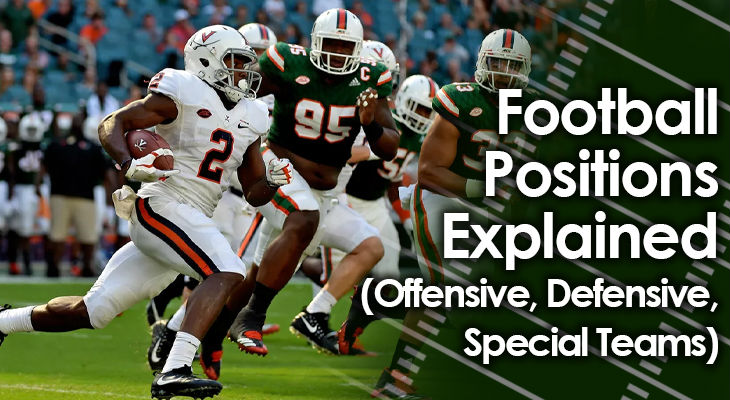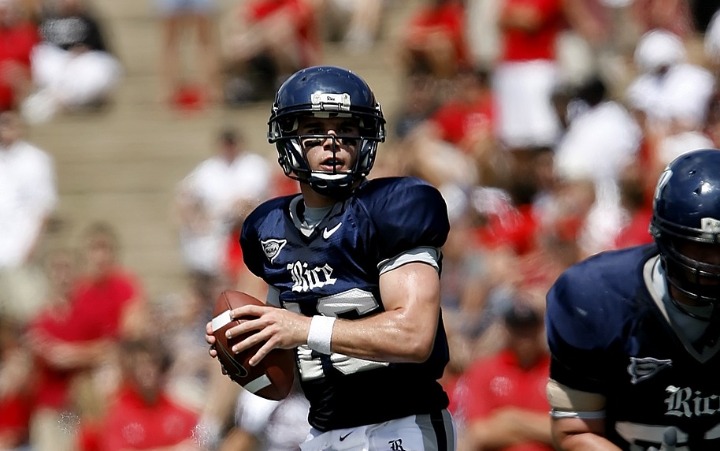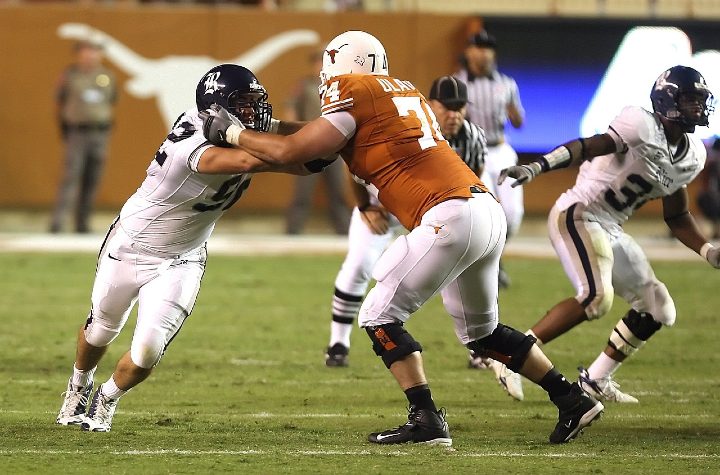Unlike a lot of other sports, it’s rather difficult to understand all the various football positions on a team.
While there are only 11 players on each team on the field at any one time, there are three distinct "units" for each football team:
- The Offense
- The Defense
- Special Teams
This means that there are 33 different football positions -- or slight variations of positions -- throughout a game.
What makes understanding football positions even more challenging is that even though some positions look the same throughout all three units, the responsibility of that position often changes from one unit to the next, if ever so slightly.
Football positions also just can't be explained quickly.
There is more depth to each position in football than there is in a sport like baseball, for example.
Each position has a primary responsibility, of course, but some positions could also have one responsibility on one play, and then a completely different responsibility on another play.
In addition to that, not every play will feature the same personnel for each unit.
Unlike baseball, where there is a first baseman on every play, for example, there may be a free safety for one play in football, and then no free safety on the next.
The best way to truly understand all the various football positions, where they line up, and what their responsibilities are is to break it down unit-by-unit, "level-by-level."
Let's take a closer look.
Offensive Football Positions
The offensive unit is primarily responsible for trying to score points.
That much most people know.
They also know that the quarterback is the captain of the unit, the one who gets most of the credit for success and most of the blame for failure.
The 11 players on an offensive unit are split into five categories of players:
Quarterback
As mentioned, the quarterback is the captain of the offensive unit.
He is the one responsible for calling plays in the huddle, for making adjustments at the line of scrimmage based on what he sees with the defense, and for ultimately driving the play in a certain direction.
The quarterback often has a good arm to throw the football, is a smart player who understands the game well, and is a good leader on and off the field.
In upper levels of today's game, more and more quarterbacks also have the ability to run the football well, in addition to throwing it.
Look no further than the NFL and Baltimore Ravens young star quarterback Lamar Jackson for proof.
In the lower levels of youth football, quarterbacks don't throw the ball that often, as they simply aren't big and strong enough to do so yet.
Even still, they are responsible for running the offense -- calling plays and making sure handoffs are completed successfully.
The quarterback lines up in the backfield on every play.
The traditional position for him on the field would be under the center, crouched down to take the snap of the ball directly from center.
It's becoming more popular today for quarterbacks to start a play in a shotgun position, which means they line up about five yards behind the center.
Again, though, while this alignment is popular at higher levels of football, it isn't seen too much in the youth football game.
The quarterback has two or three main responsibilities on any given play:
- Throw the ball to an open receiver
- Hand the ball off to a running back
- Carry the ball himself (sometimes)
While his key responsibilities are simple, they are not always easy to do.
The quarterback is tasked with not only reading defenses before the ball is snapped, but also after it's snapped to see how they react, and where the opportunities are.
Running Backs
Depending on the level of football, the style of offense, and the formation that's being run, there could be no running backs on the field for the offense or as many as four on any one play.
No matter what the situation is though, running backs will almost always line up in the backfield.
In the most traditional offensive alignments, there will be one running back on the field, and he will line up either…
- Directly behind the quarterback about five yards back (if the quarterback is under center).
- Parallel to the quarterback a few yards to his right or left (if the quarterback is in shotgun).
In pro-style formations, a fullback might be added to the equation.
In option formations such as the Flexbone, there may be four running backs on the field at the same time, aligned in various positions to cause confusion with the defense.
A running back has three main responsibilities:
- Take handoffs/pitches and run with the football
- Run a passing route and catch the football
- Block
What a running back does on a certain play will depend on the play that is being called.
Wide Receivers
Wide receivers are typically the taller, faster players on the offense who also have good hands and can catch the ball well.
There can be as many as five wide receivers on the field at one time (although that's rare) and as few as none (also rare).
Typically speaking, a base offense will have two wide receivers on the field for every play.
Youth football teams may reduce that number down to one, while professional teams often like to add at least one more to bring the total to three.
Again, it truly depends on what type of offense your team likes to run.
Wide receivers will most of the time line up wide, near the sidelines of the field.
Some wide receivers will line up on the line of scrimmage, while others will line up slightly in the backfield.
Some offensive plays may call for wide receivers to be spread out, or bunched up in Trips formations, for example.
A wide receiver has two main responsibilities:
- Run a passing route and catch the football
On passing plays, wide receivers will run a specific route and try to create separation between defenders.
If they get open, the quarterback may throw them the football.
On running plays, wide receivers will have blocking assignments to create open holes on the field for the ball carrier.
At times, wide receivers will also be tasked with taking a handoff or pitch and running the football as well.
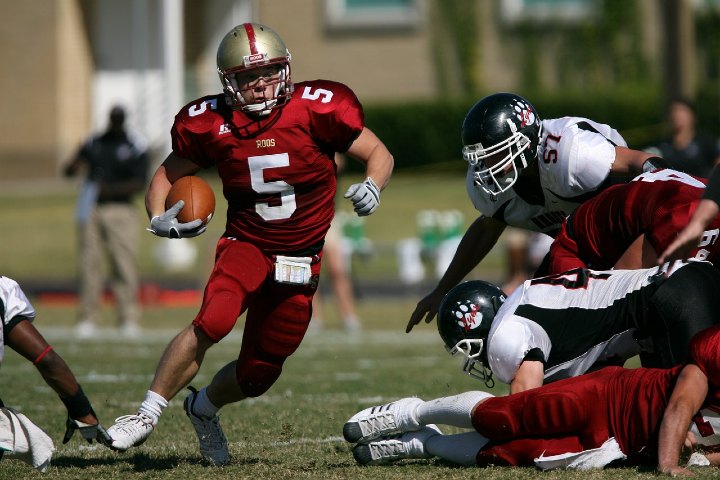
Offensive Linemen
Offensive linemen are the "big boys" on your team.
They are the players who line up at the line of scrimmage each play and are asked to block.
It's a hard-nosed position with a lot of contact on each and every play.
On just about every offensive play, there will be at least five offensive linemen on the field -- one center, two guards and two tackles.
In the NFL and college football, teams may add an additional offensive lineman or two on some plays -- specifically in short-yardage situations for a running play.
Youth football teams may have additional linemen on the field for every play.
Offensive linemen will almost always start the play in a three-point stance, with one hand on the ground.
This gets them lower to the ground to give them more leverage to block and helps them with momentum getting off the ball.
An offensive lineman has one responsibility:
Block.
The style of blocking differs slightly with running plays and passing plays.
On running plays, offensive linemen are responsible for pushing defenders aside and opening up holes for ball carriers.
They also have the ability to block downfield as well.
On passing plays, their job is to defend the quarterback from players looking to get in the backfield.
Tight Ends
Tight ends are a hybrid position -- part offensive lineman and part wide receiver.
They will almost always line up on the line of scrimmage right next to one of the offensive tackles, but their responsibilities may change depending on the play called and the level of football.
In higher levels like the NFL, tight ends catch the ball a lot.
They are some of the best athletes on the field, because they combine size and strength with speed and catching skill.
In lower levels of the game, tight ends will primarily block and serve as an additional offensive lineman.
As such, tight ends have two main responsibilities:
- Run routes and catch passes
Defensive Football Positions
On the other side of the ball is the defense.
This unit is tasked with one simple goal -- prevent the offense from scoring.
Again, while the task is straightforward, it is certainly not an easy task.
Doing so requires the complete cohesion and teamwork of all 11 players on the field at the same time.
The 11 players on defense are split into three categories of players:
Defensive Linemen
Like the offensive linemen, the defensive linemen are the big boys up front on your defense.
They will most often start every play right at the line of scrimmage and be in a three-point stance with one hand on the ground.
This stance is done to start them closer to the ground, giving them more leverage in the process and allowing them to explode through the line at the snap.
Typically speaking, defensive linemen are categorized as either tackles or ends.
a. Defensive Tackles
The tackles line up closer on the line to the ball, while the ends line up further wide on the line of scrimmage.
Tackles are normally the bigger of the two, while ends are quicker.
In most cases, there will be three or four defensive linemen on the field on every play.
These are the two base defenses that most teams run.
There may be times when a lineman is taken away or added, depending on the situation of the game.
Tackles have a few main responsibilities:
- Plug holes in the middle of the line to create openings for other defenders to stop the play
A defensive tackle may not light up the stat sheet with a lot of sacks or tackles.
Some tackles -- especially nose tackles -- make their presence felt simply by disrupting the offense's blocking scheme by forcing multiple offensive linemen to try to block him.
The primary duty for defensive tackles is to cause disruption in the middle of the field.
When they perform this duty well, other defenders will benefit.
b. Defensive Ends
Defensive ends, meanwhile, are the players who rack up the high sack totals.
They are often the quicker (and sometimes smaller) of the two defensive linemen positions, but they are in no way not strong.
They often line up across from tight ends or offensive tackles, so they must deal with big, strong, physical, and quick players.
Ends have a few main responsibilities:
- Make a tackle on a ball carrier
- Drop in coverage (sometimes)
The first two responsibilities are pretty self-explanatory.
The fourth will happen at times, but rarely.
In fact, defensive ends will only really be asked to drop back in coverage at the collegiate and professional levels, where defenses will run more complicated schemes.
Keeping outside contain is a responsibility that only a defensive end has.
It's a straightforward task, but it can be very challenging to accomplish.
What it means is that defensive ends are responsible for not allowing ball carriers to get to the outside of the field, outside of them.
If the end is not able to make the tackle himself, then his job is to force the runner back into the middle of the field, where there is more defensive help waiting in the form of linebackers and safeties.
If runners are able to break outside contain, then they'll have a better chance of gaining big yards, since there are fewer defenders there, and those defenders are often the worst tacklers of the unit.
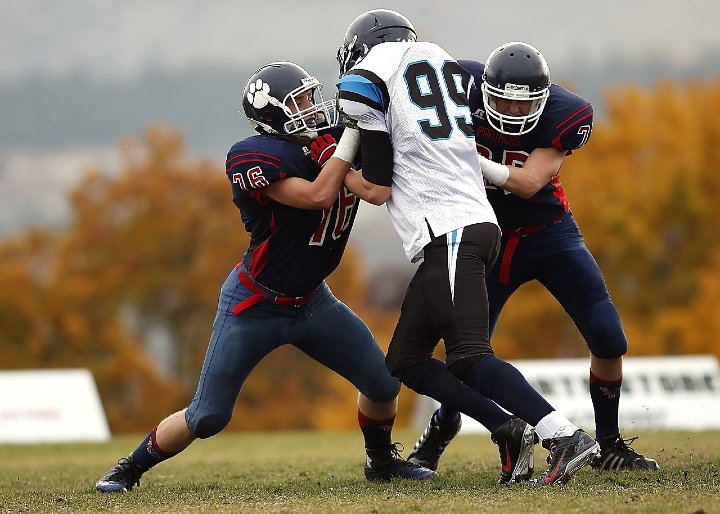
Linebackers
Linebackers are considered the second level of the defense.
They will line up about five yards or so behind the defensive linemen, evenly spread out from side-to-side from just outside the last offensive lineman on the line of scrimmage.
They start all plays in the two-point stance with their hands on their hips.
This more upright position allows them to be able to see the hole field before the snap, which is critical since how they react to a play depends on how they read a play before and after the snap.
Typically speaking, a defense will have three linebackers on the field on all plays -- the middle linebacker (also known as the Mike), the strongside linebacker (the Sam), and the weakside linebacker (the Will).
The Mike lines up in the middle of the field on most plays, while the Sam and the Will switch sides of the field depending on where the "strong" side is.
That strong side is either where the tight end lines up (if there is only one tight end) or the side of the field that is the same as the quarterback's handedness (if there is one tight end on each side).
Linebackers have three main responsibilities:
- Make tackles of ball carriers
- Rush the quarterback
- Drop back in coverage
Each linebacker will have slightly different duties on each play, and each linebacker will also tend to do one thing more than the other.
The Mike:
The Mike linebacker is considered the captain of the defense and often calls the plays in the huddle.
He is also the player most responsible for recognizing certain plays and tendencies of the offense and then calling that out to the other defenders pre-snap.
The Mike is built more for run stopping than pass coverage in most cases, although when he does drop in coverage, his primary responsibility is often to cover the tight end -- if the defense calls a man-to-man coverage scheme.
The Will:
The Will linebacker will often blitz the quarterback more than the other linebackers.
He is often the smallest and fastest of the three at the second level.
That doesn't mean he won't pitch in on run stoppage, but his strength is often blitzing and coverage.
His man-to-man coverage responsibilities are often running backs and sometimes wide receivers.
The Sam:
The Sam linebacker is usually a good run-stuffer, and he is sometimes a little bigger and stronger than the Will because he has to deal with the tight ends a lot.
That doesn't mean the Sam won't blitz or isn't fast.
He does need to be versatile, too, as he will be responsible for covering either tight ends, running backs and even wide receivers in pass coverage at times.
Secondary
The secondary is the third level of the defense -- the last level before the end zone.
This unit is made up of two positions, cornerbacks and safeties.
Their primary skillsets are slightly different than each other, even though these players are often the fastest and best in pass coverage among the defense.
On most plays, there will be two cornerbacks on the field.
Then, there will be a free safety and a strong safety on the field as well.
In either Dime or Nickel defenses, there may be an extra cornerback or two added to the mix in place of either a safety or linebacker.
Cornerbacks
Cornerbacks are normally the best man-to-man pass coverage players on the defense.
They typically have similar skillsets to the wide receivers who they are covering, except they may be a little shorter and not have as great of hands.
Their core strength is coverage, and they may not be the best tacklers on the field.
Cornerbacks have two main responsibilities:
What they do on a particular play is reliant completely on whether the offense is running or passing the ball.
On a run play, their job is to get near the ball carrier if he comes their way.
Primarily, they'll want to try to shed a block and force the runner to the inside of the field where the better tacklers are -- primarily the linebackers and strong safety.
They may also need to make a tackle, though, of course.
In pass coverage, they'll either have man-to-man responsibilities for a specific receiver, or they'll drop into zone coverage and be responsible for covering whatever player enters their zone on the field.
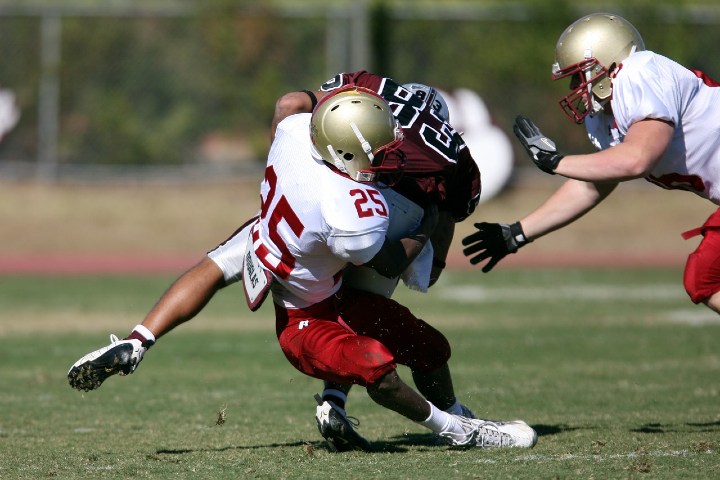
Safeties
Safeties are a little bit more of freelance players on the field.
They line up much deeper over the middle of the field, and are the last stopgap for the defense on both running and passing plays.
Safeties have the same two responsibilities as the cornerbacks, although they do so in different ways.
Free safeties are the players who most likely stay over the top in pass coverage, shading to one side of the field or the other depending on where extra help is needed (on zone coverage).
Strong safeties, meanwhile, are built similar to outside linebackers and will sometimes line up close to the line of scrimmage.
They are usually solid tacklers and will blitz the quarterback more often than free safeties.
Special Teams:
Special teams are the units that have to do with the kicking game, whether that be the punt coverage or return team, the kick coverage or return team, or the field goal and extra point attempt or block team.
Their job is to primarily score points, prevent points from being scored, pin the other team deep for field positioning, or return the ball as far as possible to set the offense up into good shape.
In lower levels of football, the special teams units will be made up of players who also play on offense and/or defense.
In upper levels, there will be almost a completely unique team of players for special teams.
The make-up of special teams is a mix of linemen and skill players - those who are blocking and setting up the play, and those who are running downfield to make a tackle, trying to block a kick, or returning the football.
The only completely unique players on special teams are the kickers.
In upper levels of the game, there will be a separate punter and place kicker.
The punter will handle only punts, looking to pin the other team deep to make it harder for their offense.
The place kicker will handle kickoff duties -- with the same goal of the punter -- and also scoring attempts such as field goals and extra points.

